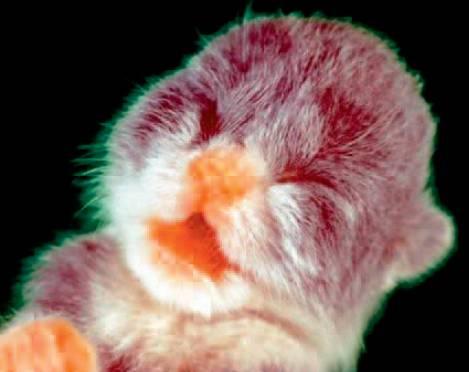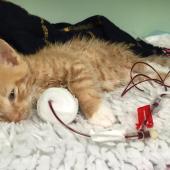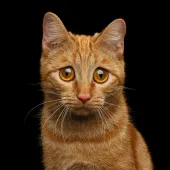Blood groups and incompatibilites

When a cat experiences severe illness, surgery, or trauma resulting in significant blood loss or anemia, a blood transfusion might be necessary to save their life. While blood transfusions can be lifesaving, they are complex medical procedures that require careful consideration. This article aims to provide cat owners with essential information about blood transfusions, helping them understand the procedure, its benefits, and the important factors to consider when deciding if it's right for their feline companion.
Blood groups and incompatibilites
Similar to people, cats can have various genetically determined blood types. If your cat needs a blood transfusion or has mated with another cat that has a different blood type, it is crucial to know what kind of blood group they are.
Why does it matter which blood group my cat has?
The major blood groups for cats are Type A and Type B but a very small proportion can be Type AB (sometimes referred to as Type C). Type A is a dominant gene and B is recessive. Type AB is recessive to Type A but dominant to Type B. Another subtype has also been discovered; some type A cats carry a “Mik” gene.
If a cat has a Type A blood group, it has antibodies against Type B blood (and vice versa). Type AB cats do not have anti-A or anti-B antibodies. Blood group types are important in blood transfusions and a condition in kittens known as neonatal isoerythrolysis.
Blood transfusions
When a cat receives a blood transfusion from another cat that has a different blood type—that is, when a Type A cat receives a Type B blood—transfusion reactions may develop. The immune system will eliminate the new red blood cells because it believes they are "foreign." This may cause the cat to pass away or, at the absolute least, make the blood transfusion less successful because the red blood cells may not live as long.
Before administering a transfusion, your veterinarian should test your cat to ascertain its blood type in order to avoid a serious transfusion reaction. Additionally, cross-matching can be used to find smaller incompatibilities, such those brought on by Mik's existence.
Neonatal isoerythrolysis (fadding kitten syndrome)
This condition can arise following the mating of a Type A or AB tom with a Type B queen. Some of the resulting kittens will have a different blood type to the mother, and in these, anti-B antibodies transferred with the first milk (colostrum) can cause destruction of the red blood cells in the Type A (or Type AB) kitten; this is neonatal isoerythrolysis.

How will I know which blood type my cat has?
Your veterinarian can quickly and easily do an in-office blood type on your cat using a card or test strip. Blood can also be tested for blood type in veterinary labs. Cats can also be tested for Type B status by sending cheek swabs to owners and breeders. The less common Type AB and Type A cannot be distinguished by this test.
The most prevalent blood group in most nations is Type A. The prevalence of Type B cats varies greatly and can reach over 20% in certain nations and areas. The majority of non-pedigree cats in the UK are Type A, with Type B and even fewer Type AB cats making up minor percentages. On the other hand, it does seem that the percentage of Type B in non-pedigree cats is rising.
The prevalence of Type B is higher in cats from pedigrees. Type B is more common in Persian, Somali, and Abyssinian breeds as well as breeds like Devon Rex, British Shorthairs, Ragdolls, and Birmans. Certain breeds (such as Bengal, Birman, and Ragdoll) may have an exceptionally high percentage of Type AB cats in specific regions.
What will happen if a kitten develops neonatal isoerythrolysis?
At birth, affected kittens may seem healthy, but during the first few days, they quickly deteriorate (fading kitten syndrome). Neonatal isoerythrolysis will cause anemia in kittens, and they may need a blood transfusion in addition to extensive therapy in order to live. Tail tip necrosis—the death of the very tip of the tail—may occur in kittens who recover from treatment.
How can neonatal isoerythrolysis be prevented?
Potential issues can be anticipated and averted if the blood types of the tom and queen are recognized. In order to prevent the kittens from ingesting the antibodies found in the colostrum of the queen, if an incompatible mating has occurred, they should be taken from her before they can nurse and hand raised or fostered for the first 48 hours after birth. The kittens can be returned to the queen if, upon testing after birth, it is discovered that their blood type matches hers.
Several approaches can then be taken :
- Steer clear of breeding group B cats at all costs. While this solves the issue, it may also reduce the number and variety of cats available for breeding, which may be undesirable for other reasons.
- Group B queens should only mate with group B toms. This will also prevent the issue, but it will once again restrict the options for mating. Since all progeny from these matings will be group B, there may be a tendency for this strategy to progressively increase the percentage of group B cats within a breed.
- During the first twenty-four hours of their lives, keep type A kittens from nursing on colostrum from a group B queen. Numerous breeders have employed this strategy, and it can be effective. Using blood from the umbilical chord, newborn kittens must be blood typed. Any group B kittens in the litter can be allowed to nurse from the queen, but type A and AB kittens must be taken from her. Removed kittens must be raised by hand for the first twenty-four hours of their lives (or with a type A foster queen that is nursing). After that, they can be returned to the queen because their intestines will no longer be able to absorb antibodies.
Approximate frequency of type B cats in various breeds
Note this is for guidance only and will vary between countries and regions
Breeds with only type A or a low frequency of type B (less than 10%)
Breeds with an intermediate frequency of type B cats (10-25%)
- Abyssinian
- Birman
- Burmese
- Himalayan
- Persian
- Somali
- Sphynx
Breeds with a high frequency of type B cats (more than 25%)
- British Shorthair
- Cornish Rex
- Devon Rex
- Exotic
- Ragdoll
- Turkish Angora
- Turkish Van



